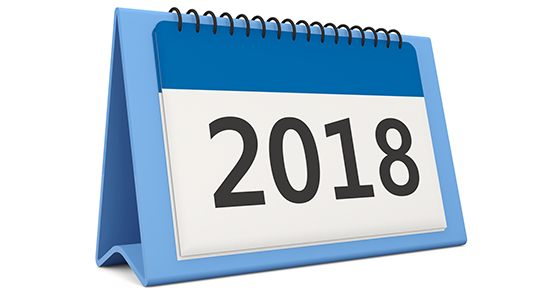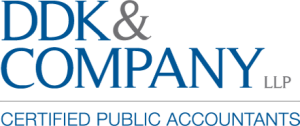
2018 Tax Calendar
To help you make sure you don’t miss any important 2018 deadlines, we’ve provided this summary of when various tax-related forms, payments and other actions are due. Be aware that some deadlines have been moved up or pushed back compared to previous years. Please review the calendar and let us know if you have any questions about the deadlines or would like assistance in meeting them.
| Date | Deadline for |
| February 12 | Individuals: Reporting January tip income, $20 or more, to employers (Form 4070).
Employers: Reporting income tax withholding and FICA taxes for fourth quarter 2017 (Form 941) and filing a 2017 return for federal unemployment taxes (Form 940), if you deposited on time and in full all of the associated taxes due. |
| February 15 | Businesses: Providing Form 1099-B, 1099-S and certain Forms 1099-MISC (those in which payments in Box 8 or Box 14 are being reported) to recipients.
Individuals: Filing a new Form W-4 to continue exemption for another year, if you claimed exemption from federal income tax withholding in 2017. |
| February 28 | Businesses: Filing Form 1098, Form 1099 (other than those with a January 31 or February 15 deadline) and Form W-2G and transmittal Form 1096 for interest, dividends and miscellaneous payments made during 2017. (Electronic filers can defer filing to April 2.) |
| March 12 | Individuals: Reporting February tip income, $20 or more, to employers (Form 4070). |
| March 15 | Calendar-year S corporations: Filing a 2017 income tax return (Form 1120S) or filing for an automatic six-month extension (Form 7004), and paying any tax due.
Calendar-year partnerships: Filing a 2017 income tax return (Form 1065 or Form 1065-B) or requesting an automatic six-month extension (Form 7004). |
| April 2 | Employers: Electronically filing 2017 Form 1096, Form 1098, Form 1099 (other than those with an earlier deadline) and Form W-2G. |
| April 10 | Individuals: Reporting March tip income, $20 or more, to employers (Form 4070). |
| April 17 | Individuals: Filing a 2017 income tax return (Form 1040, Form 1040A or Form 1040EZ) or filing for an automatic six-month extension (Form 4868), and paying any tax due. (See June 15 for an exception for certain taxpayers.)
Individuals: Paying the first installment of 2018 estimated taxes, if not paying income tax through withholding (Form 1040-ES). Individuals: Making 2017 contributions to a traditional IRA or Roth IRA (even if a 2017 income tax return extension is filed). Individuals: Making 2017 contributions to a SEP or certain other retirement plans (unless a 2017 income tax return extension is filed). Individuals: Filing a 2017 gift tax return (Form 709) or filing for an automatic six-month extension (Form 8892), and paying any gift tax due; or filing for an automatic six-month extension (Form 4868) to extend both Form 1040 and, if no gift tax is due, Form 709. Household employers: Filing Schedule H (Form 1040), if wages paid equal $2,000 or more in 2017 and Form 1040 is not required to be filed. For those filing Form 1040, Schedule H is to be submitted with the return and is thus extended to the due date of the return. Trusts and estates: Filing an income tax return for the 2017 calendar year (Form 1041) or filing for an automatic five-and-a-half month extension to October 1 (Form 7004), and paying any income tax due. Calendar-year C corporations: Filing a 2017 income tax return (Form 1120) or filing for an automatic six-month extension (Form 7004), and paying any tax due. Calendar-year corporations: Paying the first installment of 2018 estimated income taxes. |
| April 30 | Employers: Reporting income tax withholding and FICA taxes for first quarter 2018 (Form 941), and paying any tax due. |
| May 10 | Individuals: Reporting April tip income, $20 or more, to employers (Form 4070).
Employers: Reporting income tax withholding and FICA taxes for first quarter 2017 (Form 941), if you deposited on time and in full all of the associated taxes due. |
| May 15 | Exempt organizations: Filing a 2017 calendar-year information return (Form 990, Form 990-EZ or Form 990-PF) or filing for an automatic six-month extension (Form 8868) and paying any tax due.
Small exempt organizations (with gross receipts normally of $50,000 or less): Filing a 2017 e-Postcard (Form 990-N), if not filing Form 990 or Form 990-EZ. |
| June 11 | Individuals: Reporting May tip income, $20 or more, to employers (Form 4070). |
| June 15 | Individuals: Filing a 2017 individual income tax return (Form 1040) or filing for a four-month extension (Form 4868), and paying any tax and interest due, if you live outside the United States.
Individuals: Paying the second installment of 2018 estimated taxes, if not paying income tax through withholding (Form 1040-ES). Calendar-year corporations: Paying the second installment of 2018 estimated income taxes. |
| July 10 | Individuals: Reporting June tip income, $20 or more, to employers (Form 4070). |
| July 31 | Employers: Reporting income tax withholding and FICA taxes for second quarter 2018 (Form 941), and paying any tax due.
Employers: Filing a 2017 calendar-year retirement plan report (Form 5500 or Form 5500-EZ) or requesting an extension. |
| August 10 | Individuals: Reporting July tip income, $20 or more, to employers (Form 4070).
Employers: Reporting income tax withholding and FICA taxes for second quarter 2018 (Form 941), if you deposited on time and in full all of the associated taxes due. |
| September 10 | Individuals: Reporting August tip income, $20 or more, to employers (Form 4070). |
| September 17 | Individuals: Paying the third installment of 2018 estimated taxes, if not paying income tax through withholding (Form 1040-ES).
Calendar-year corporations: Paying the third installment of 2018 estimated income taxes. Calendar-year S corporations: Filing a 2017 income tax return (Form 1120S) and paying any tax, interest and penalties due, if an automatic six-month extension was filed. Calendar-year S corporations: Making contributions for 2017 to certain employer-sponsored retirement plans, if an automatic six-month extension was filed. Calendar-year partnerships: Filing a 2017 income tax return (Form 1065 or Form 1065-B), if an automatic six-month extension was filed. |
| October 1 | Trusts and estates: Filing an income tax return for the 2017 calendar year (Form 1041) and paying any tax, interest and penalties due, if an automatic five-and-a-half month extension was filed.
Employers: Establishing a SIMPLE or a Safe-Harbor 401(k) plan for 2018, except in certain circumstances. |
| October 10 | Individuals: Reporting September tip income, $20 or more, to employers (Form 4070). |
| October 15
|
Individuals: Filing a 2017 income tax return (Form 1040, Form 1040A or Form 1040EZ) and paying any tax, interest and penalties due, if an automatic six-month extension was filed (or if an automatic four-month extension was filed by a taxpayer living outside the United States).
Individuals: Making contributions for 2017 to certain existing retirement plans or establishing and contributing to a SEP for 2017, if an automatic six-month extension was filed. Individuals: Filing a 2017 gift tax return (Form 709) and paying any tax, interest and penalties due, if an automatic six-month extension was filed. Calendar-year C corporations: Filing a 2017 income tax return (Form 1120) and paying any tax, interest and penalties due, if an automatic six-month extension was filed. Calendar-year C corporations: Making contributions for 2017 to certain employer-sponsored retirement plans, if an automatic six-month extension was filed. |
| October 31
|
Employers: Reporting income tax withholding and FICA taxes for third quarter 2018 (Form 941) and paying any tax due. |
| November 13 | Individuals: Reporting October tip income, $20 or more, to employers (Form 4070).
Employers: Reporting income tax withholding and FICA taxes for third quarter 2018 (Form 941), if you deposited on time and in full all of the associated taxes due. |
| November 15
|
Exempt organizations: Filing a 2017 calendar-year information return (Form 990, Form 990-EZ or Form 990-PF) and paying any tax, interest and penalties due, if a six-month extension was previously filed. |
| December 10
|
Individuals: Reporting November tip income, $20 or more, to employers (Form 4070). |
| December 17
|
Calendar-year corporations: Paying the fourth installment of 2018 estimated income taxes. |
| December 31 | Employers: Establishing a retirement plan for 2018 (generally other than a SIMPLE, a Safe-Harbor 401(k) or a SEP). |
